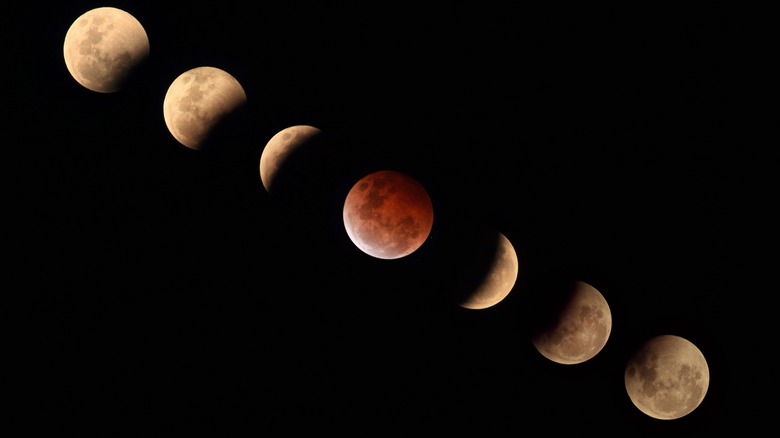Earth's Moon Will Experience A Rare Color Change In March 2025
We may receive a commission on purchases made from links.
The first quarter of the year has gotten off to a phenomenal start when it comes to cosmic events. These include a four-planet alignment in January 2025 (a six-planet alignment with a telescope) and a rare, seven-planet alignment in February 2025 alongside several other interesting changes in the sky. March 2025 will be no different with a total lunar eclipse that will make the moon look blood red.
Starting the evening of March 13 and going into the early morning of March 14, the moon will pass into the shadow (called the umbra) created by the sun's light cast on Earth. Think of it like an image with the sun on one side, Earth in the middle, and the moon on the opposite side of Earth from the sun. While the moon is in the shadow — the darkest part of the shadow — it has a red-orange hue, which is why a lunar eclipse is also referred to as a "blood moon."
Unlike the phenomenon of super blue moons (since the moon isn't actually blue), the color change happens because the reddish light from the sun travels straighter than the blue light, which scatters. So, during the total lunar eclipse, red light from the sun passes through part of Earth's atmosphere while blue light bounces off of it, resulting in the moon looking red-orange. It's the same reason why the sky appears so yellowish red at sundown and sunrise but more blue during the day.
What to expect during the March 2025 total lunar eclipse
The March 2025 total lunar eclipse will be visible across all of the United States, except for the western side of Alaska and Hawaii. Also, it will be the last blood moon for a while that most of the Americas will be able to see because the moon's orbit around Earth is tilted, which is what prevents it from passing into the umbra shadow every month. Knowing exactly what to expect during the event will ensure that you don't miss it.
Like with a total solar eclipse (one of many general types of eclipses), the orbital movement of the Earth and moon means that a lunar total eclipse happens in stages. In mid-March 2025, the phenomenon will start at 11:57 p.m. EDT with the Moon entering Earth's penumbra shadow (the outer shadow). It will start moving into the umbra at 1:09 a.m., creating a partial eclipse, and be totally encompassed by the umbra from 2:26 a.m. to 3:31 a.m. — appearing a coppery red. Then, the moon will move into the other side of the penumbra, creating another partial eclipse until 4:47 a.m. The entire event will be over by 6 a.m.
Having a pair of binoculars — like the Occer 12x25 Compact Binoculars — or a telescope — like the MEEZZAA High Powered Professional Telescope — will enhance your view, but isn't required. Additionally, the blood moon isn't the only interesting part of the cosmos to look at during the one-hour, five-minute period of totality. That's because it will be easier than usual to spot constellations in the sky while the moon's light is dimmed by Earth's shadow. It will be easier to observe Mars and Jupiter in the western sky as well.

